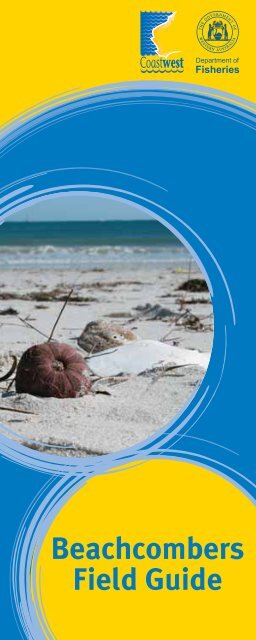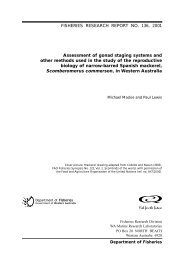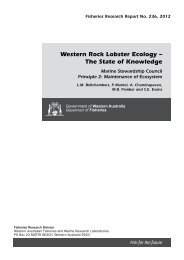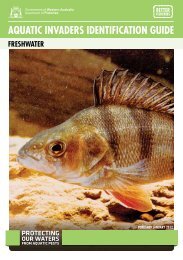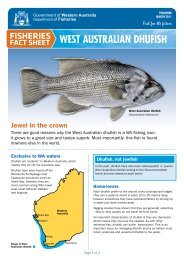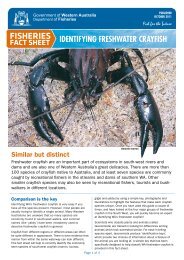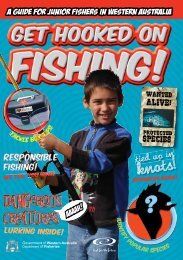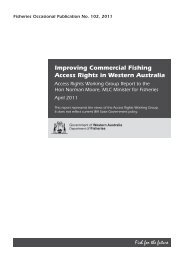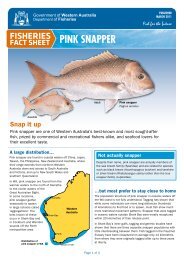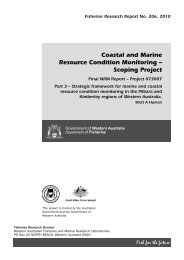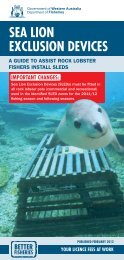Beachcombers Field Guide - Department Of Fisheries Western ...
Beachcombers Field Guide - Department Of Fisheries Western ...
Beachcombers Field Guide - Department Of Fisheries Western ...
You also want an ePaper? Increase the reach of your titles
YUMPU automatically turns print PDFs into web optimized ePapers that Google loves.
<strong>Beachcombers</strong><br />
<strong>Field</strong> <strong>Guide</strong>
The <strong>Beachcombers</strong> <strong>Field</strong> <strong>Guide</strong> has been<br />
made possible through funding from<br />
Coastwest and the <strong>Western</strong> Australian<br />
Planning Commission, and the<br />
<strong>Department</strong> of <strong>Fisheries</strong>, Government<br />
of <strong>Western</strong> Australia.<br />
The project would not have been possible<br />
without our community partners – Friends<br />
of Marmion Marine Park and Padbury<br />
Senior High School.<br />
Special thanks to Sue Morrison, Jane<br />
Fromont, Andrew Hosie and Shirley Slack-<br />
Smith from the <strong>Western</strong> Australian Museum<br />
and John Huisman<br />
for editing the<br />
fi eld guide.<br />
FRIENDS<br />
OF<br />
Acknowledgements
The <strong>Beachcombers</strong> <strong>Field</strong> <strong>Guide</strong> is an easy<br />
to use identifi cation tool that describes<br />
some of the more common items you may<br />
fi nd while beachcombing.<br />
For easy reference, items are split into<br />
four simple groups:<br />
• Chordates (mainly vertebrates –<br />
animals with a backbone);<br />
• Invertebrates (animals without a<br />
backbone);<br />
• Seagrasses and algae; and<br />
• Unusual fi nds!<br />
Chordates and invertebrates are then<br />
split into their relevant phylum and class.<br />
Phyla Perth include: Beachcomber <strong>Field</strong> <strong>Guide</strong><br />
• Chordata (e.g. fi sh)<br />
• Porifera (sponges)<br />
• Bryozoa (e.g. lace corals)<br />
• Mollusca (e.g. snails)<br />
• Cnidaria (e.g. sea jellies)<br />
• Arthropoda (e.g. crabs)<br />
• Annelida (e.g. tube worms)<br />
• Echinodermata (e.g. sea stars)<br />
Beachcombing<br />
Basics
• Wear sun protective clothing, including<br />
a hat and sunscreen.<br />
• Take a bottle of water – it can get hot<br />
out in the sun!<br />
• Take a hand lens or magnifying glass<br />
for closer inspection.<br />
• Be careful when picking items up –<br />
you never know what could be hiding<br />
inside, or what might sting you!<br />
• Help the environment and take any<br />
rubbish safely home with you – recycle<br />
or place it in the bin.<br />
Perth • Take Beachcomber your camera <strong>Field</strong> to help <strong>Guide</strong> you to<br />
capture memories of your fi nds.<br />
• Leave marine life on the beach<br />
where you found it – each plant and<br />
animal plays an important part in<br />
the environment.<br />
• Leave only your footprints…<br />
It is always important<br />
to be prepared, so you<br />
can make the most of your<br />
beachcombing experience
Photo: Cottesloe Coastcare<br />
Globefi sh
Globefi sh (Diodon nicthemerus)<br />
Chordata – Osteichthyes<br />
Also referred to as<br />
a porcupinefi sh, the name<br />
certainly refl ects this fi sh’s appearance<br />
with a body that can be infl ated, causing<br />
the spines (which are modifi ed scales)<br />
to stand erect. A globefi sh infl ates its<br />
body by ingesting water or air, and as its<br />
body expands the spines lock into place<br />
– making the animal appear much bigger<br />
and acting as a deterrent<br />
to potential<br />
predators.<br />
Photo: Carina Gemignani<br />
Did you know?<br />
The swim bladder of the<br />
porcupinefi sh may also be found<br />
washed up onto the beach – the<br />
infl ated dried organ is sometimes<br />
referred to as a windbag.
Photo: Sandy Clarke<br />
Weeping toadfish
Weeping toadfi sh<br />
(Torquigener pleurogramma)<br />
Chordata – Osteichthyes<br />
Commonly referred<br />
to as a blowie, these pufferfi sh<br />
are considered to be a nuisance to<br />
recreational fi shers because they gobble<br />
up bait, making it hard for fi shers to catch<br />
other species. However, blowies play an<br />
important role in marine ecosystems, as<br />
they are omnivorous (plant- and animaleaters)<br />
and feed on almost anything they<br />
can scavenge. They consume<br />
waste scraps, bait and<br />
burley along with<br />
its normal diet,<br />
and therefore<br />
help to keep<br />
our coastal<br />
waters<br />
clean.<br />
Photo: Henrique Kwong<br />
Did you know?<br />
Pufferfi sh produce a highly<br />
lethal toxin called tetrodotoxin<br />
– present in their skin, fl esh and<br />
internal organs. Do not allow dogs<br />
to mouth any dead fi sh, as they can<br />
ingest suffi cient toxin to kill them.
Photo: Gilbert Stokman<br />
Shaw’s cowfi sh
Shaw’s cowfi sh (Aracana aurita)<br />
Chordata – Osteichthyes<br />
Shaw’s cowfi sh<br />
belong to the boxfi sh family.<br />
Unlike most other bony fi shes, boxfi sh<br />
have an outer covering of large, thick<br />
bony plates, that provide a protective<br />
armour against predators. Because of<br />
this armour, boxfi sh cannot swim very<br />
fast to hunt, so they feed by blowing a<br />
jet of water at the sand to expose prey<br />
hidden beneath.<br />
Photo: Carina Gemignani<br />
Did you know?<br />
Boxfi sh are one of the bony<br />
fi sh families that display sexual<br />
dimorphism. This means that<br />
you can tell the difference<br />
between males and females by<br />
the colours, patterns and<br />
markings on their bodies.
Photo: Sandy Clarke<br />
Common<br />
seadragon
Common seadragon<br />
(Phyllopteryx taeniolatus)<br />
Chordata – Osteichthyes<br />
Although in the<br />
same family (Syngnathidae),<br />
the common seadragon is sometimes<br />
confused with the seahorse, however,<br />
seadragons don’t have a prehensile tail<br />
(one with the ability to grasp onto objects).<br />
The common seadragon is only found in<br />
temperate waters of southern Australia.<br />
Growing up to 46 cm in length, the armourcoated<br />
body can sometimes<br />
be found washed up<br />
onto the beach<br />
by a lucky<br />
beachcomber.<br />
Photo: Shannon Conway<br />
Did you know?<br />
Closely related to the<br />
common seadragon is the<br />
leafy seadragon. This species<br />
of seadragon is generally yellow<br />
to brown in colour and has more<br />
leaf-like appendages on its body.<br />
This makes it incredibly well<br />
camoufl aged among marine algae.
Photo: Sandy Clarke<br />
West Australian<br />
seahorse
West Australian seahorse<br />
(Hippocampus subelongatus)<br />
Chordata – Osteichthyes<br />
Seahorses have bony<br />
plates protecting their bodies<br />
instead of scales. Their long snouts<br />
end in tiny, toothless mouths that suck in<br />
minute crustaceans, which are swallowed<br />
whole. The West Australian seahorse<br />
varies in colour but can be distinguished<br />
by a series of brown lines across the<br />
snout. Growing to about 22 cm in length,<br />
they are found in sheltered<br />
reefs, sponge<br />
gardens and<br />
seagrass<br />
beds in a<br />
limited<br />
area of<br />
the south<br />
west of<br />
<strong>Western</strong><br />
Australia.<br />
Photo: Sandy Clarke<br />
Did you know?<br />
Most species of seahorse live<br />
in pairs. Female seahorses pass<br />
their eggs to the males, who<br />
incubate them in a protective<br />
pouch. He later ‘gives birth’ to<br />
highly developed offspring.
Photo: Michelle Dyer<br />
Sea squirt
Sea squirt<br />
Chordata – Ascidiacea<br />
Attached to the reef,<br />
sea squirts (or ascidians) are<br />
often mistaken for sponges. These<br />
simple animals are practically a ‘sac’<br />
with two openings that siphon water in<br />
and out of the body to collect food and<br />
nutrients. Sea squirts have a thick outer<br />
coat made from a cellulose-like material.<br />
This is known as the tunic, which helps<br />
protect the animal from<br />
predators.<br />
Photo: David Fairclough<br />
Did you know?<br />
Believe it or not, sea squirts<br />
are related to humans! In their<br />
larval stage, sea squirts have<br />
a basic backbone of rod cells<br />
(notochords), just like vertebrates,<br />
such as humans, fi sh and mammals.<br />
These cells are lost as the sea<br />
squirt develops into an adult.
Sea tulip<br />
Photo: Michelle Dyer
Sea tulip<br />
Chordata – Ascidiacea<br />
Sea tulips are named<br />
for their long stalks and rounded<br />
heads. Although considered a solitary<br />
(single) ascidian, a cluster of them can<br />
look like a bunch of tulips (fl owers)<br />
attached to rocky reef or seagrass.<br />
Filtering the water for food and nutrients,<br />
these animals play an important role<br />
in our marine environment, removing<br />
particles as small as<br />
bacteria.<br />
Photo: Clay Bryce<br />
Did you know?<br />
Ascidians have free-swimming<br />
larvae, which help them to<br />
disperse throughout the ocean.<br />
However, they do not feed during<br />
this time and must fi nd a place<br />
to settle within a few hours, or<br />
they die.
Photo: Michelle Dyer<br />
Colonial ascidian
Colonial ascidian<br />
Chordata – Ascidiacea<br />
A colonial ascidian is a<br />
colony of animals (or zooids),<br />
where it is hard to distinguish<br />
separate animals – individual zooids<br />
can only be seen clearly with a<br />
microscope. They form intricate patterns<br />
and come in an assortment of colours.<br />
Ascidians are diffi cult to identify properly<br />
without examining the internal structure<br />
of the specimen.<br />
Photo: Clay Bryce<br />
Did you know?<br />
Colonial ascidians usually<br />
grow as a coating on rocks or<br />
reefs, and can be mistaken for an<br />
encrusting sponge. The difference<br />
is that ascidians have a nervous<br />
system and they respond to<br />
touch by retracting and closing<br />
their siphons.
Sponge<br />
Photo: Sandy Clarke
Sponge<br />
Porifera<br />
<strong>Of</strong>ten mistaken for<br />
plants, sponges are commonly<br />
found by beachcombers because their<br />
skeletons are strong enough to survive<br />
the waves that wash them ashore. These<br />
sponges have lost their bright colours<br />
but generally retain the shape they had<br />
when alive. Sponges have no mouth,<br />
internal organs or nerves. Instead, their<br />
body is full of tiny holes,<br />
which help them to<br />
eat and breathe<br />
by fi ltering<br />
seawater.<br />
Photo: David Fairclough<br />
Did you know?<br />
Spicules are microscopic<br />
structures that provide a support<br />
or skeleton for the animal. These<br />
hard spicules are made of either<br />
calcium carbonate (limestone)<br />
or glassy silica, and vary in size<br />
and shape.
Photo: Michelle Dyer<br />
Bryozoan
Bryozoan<br />
Bryozoa<br />
<strong>Of</strong>ten mistaken<br />
for corals, sponges or algae,<br />
bryozoans (lace coral and sea mosses)<br />
are a colony of tiny animals called zooids.<br />
Each zooid is protected by a calcareous<br />
(limestone) horny case, which is left<br />
behind when the animals die. Colony<br />
members are independent of each other,<br />
feeding on plankton and other particles<br />
suspended in the water.<br />
However, when<br />
disturbed they<br />
will act as one,<br />
retracting<br />
into their<br />
protective<br />
case.<br />
Photo: David Fairclough<br />
Did you know?<br />
Bryozoans reproduce by external<br />
fertilisation, releasing eggs and<br />
sperm into the water, which form<br />
free-swimming larvae. Larvae then<br />
attach themselves to a solid object<br />
and divide to create a new colony.
Photo: Michelle Dyer<br />
Violet snail
Violet snail<br />
Mollusca – Gastropoda<br />
There are a few<br />
species of violet snails that may<br />
be washed up on <strong>Western</strong> Australian<br />
beaches by rough seas. A violet snail fl oats<br />
upside down far out in the open ocean,<br />
clinging to a raft it creates by secreting airfi<br />
lled mucous bubbles that stick together<br />
and harden. Travelling at the mercy of<br />
ocean currents, these carnivorous snails<br />
feed on fl oating cnidarians,<br />
such as bluebottles<br />
and by-the-wind<br />
sailors.<br />
Photo: Clay Bryce<br />
Did you know?<br />
Violet snails are adapted to<br />
life on the sea surface. When<br />
viewed from above, the dark purple<br />
colouration of the shell blends<br />
with the surrounding water and<br />
when viewed from below, the lighter<br />
colour blends with the sky. This<br />
type of camoufl age is known as<br />
countershading.
Photo: Michelle Dyer<br />
Turban snail
Turban snail<br />
Mollusca – Gastropoda<br />
Turban snails are<br />
found living in rock pools and<br />
on shallow reefs along the <strong>Western</strong><br />
Australian coastline. As a protection from<br />
predators, the turban’s body can be pulled<br />
inside the shell and its aperture closed by<br />
a shelly trap door called the operculum.<br />
After the turban’s death, these trap doors<br />
may be found washed up onto the beach<br />
– in the tropics some very<br />
colourful ones are<br />
called cat’s eyes.<br />
Photo: Sam Bridgwood<br />
Did you know?<br />
You may notice scars on<br />
the outside surfaces of some<br />
turban shells. These are made<br />
by horse shoe limpets that<br />
attach themselves to the shell to<br />
feed on the turban’s mucus and<br />
body wastes.
Photo: Sandy Clarke<br />
Cone shell
Cone shell<br />
Mollusca – Gastropoda<br />
Cones live under rocks<br />
or coral boulders, and many<br />
species bury themselves in the sand<br />
with just their siphons extended like<br />
snorkels. The water sucked in through<br />
their siphon carries oxygen as well as the<br />
odour of prey, such as another mollusc,<br />
worm or a small fi sh. The cones can then<br />
rapidly harpoon their prey using a hollow,<br />
barbed tooth loaded with<br />
venom. Once the<br />
prey is paralysed<br />
it is usually<br />
swallowed<br />
whole.<br />
Photo: Sam Bridgwood<br />
Did you know?<br />
Although not all cones are<br />
dangerous to humans, it is best<br />
to treat them with caution. Mollusc<br />
and worm-eating cones can infl ict<br />
a painful sting but the venom of<br />
fi sh-eating cones can cause a human<br />
to suffer breathing diffi culties,<br />
paralysis or even death!
Photo: Sandy Clarke<br />
Baler shell
Baler shell<br />
Mollusca – Gastropoda<br />
Buried in the sand during the day,<br />
baler shells emerge at night to search<br />
for food. These large carnivorous (animaleating)<br />
gastropods smother their prey<br />
with a large muscular foot and use their<br />
muscular rasping tongue (radula) and<br />
jaws to devour prey such as abalone.<br />
Photo: David Fairclough<br />
Did you know?<br />
Baler shells were highly<br />
valued by Aborigines as storage<br />
and serving containers for food<br />
and water.
Limpet<br />
Photo: Michelle Dyer
Limpet<br />
Mollusca – Gastropoda<br />
Most limpet species have a<br />
cone-shaped shell and a muscular foot,<br />
with which they cling tightly to the reef or<br />
to other hard substrates. Grazing on algae<br />
at high tide, limpets generally return to<br />
exactly the same place where they left<br />
their mark on the rock at low-tide.<br />
Photo: Carina Gemignani<br />
Did you know?<br />
Look carefully on the rocks to<br />
see if you can see the scars or<br />
marks left behind by limpets that<br />
haven’t yet returned after feeding.
Abalone<br />
Photo: Michelle Dyer
Abalone<br />
Mollusca – Gastropoda<br />
The ear-shaped shell<br />
of an abalone is hard and rough<br />
on the outside to protect the animal<br />
from predators, and smooth and shiny on<br />
the inside to protect the soft body from<br />
damage. Water is drawn in near the front<br />
of the shell, passes through the gills,<br />
and leaves through the row of respiratory<br />
holes near the edge of the shell. Abalone<br />
are herbivores – they feed<br />
on algae mainly at<br />
night and hold on<br />
tightly to the<br />
rocks during<br />
the day.<br />
Photo: Anthony Hart<br />
Did you know?<br />
An abalone does not have a<br />
blood-clotting agent and can<br />
therefore bleed to death if it is<br />
damaged or injured when being<br />
removed from a reef.
Sea hare<br />
Photo: Sandy Clarke
Sea hare<br />
Mollusca – Gastropoda<br />
Sometimes dark slimy<br />
blobs wash up onto beaches<br />
during late summer and throughout<br />
autumn. These blobs are actually sea<br />
hares – a type of mollusc closely related<br />
to sea slugs or nudibranchs. Grazing on<br />
algae, their black, brown or purple colour<br />
(dark mottled green in some other species)<br />
acts as perfect camoufl age as they slowly<br />
crawl over the seabed.<br />
Sea hares only<br />
live for about a<br />
year – dying<br />
after laying<br />
their long<br />
tangled<br />
strings of<br />
eggs.<br />
Photo: Gilbert Stokman<br />
Did you know?<br />
Be careful if handling sea<br />
hares – when threatened, these<br />
molluscs may excrete colourless<br />
toxic slime from the skin and a<br />
cloud of purple ink that can irritate<br />
the eyes. Some species can even kill<br />
a dog if eaten or even mouthed!
Photo: Sandy Clarke<br />
Cowry shell
Cowry shell<br />
Mollusca – Gastropoda<br />
Popular with shell<br />
collectors due to their polished<br />
colourful shells, cowries generally live<br />
on sheltered inshore reefs. Young cowries<br />
have a fragile shell that is obviously<br />
spirally coiled. However, this shape is<br />
hidden as the last coil of the shell wraps<br />
around and hides the juvenile whorls.<br />
Cowries feed mostly at night, mainly on<br />
sponges. There are more<br />
than 60 species<br />
living along<br />
the <strong>Western</strong><br />
Australian<br />
coast.<br />
Photo: Ann Storrie<br />
Did you know?<br />
The shiny adult shell is due to<br />
a glassy layer that is secreted by<br />
the mantle fl aps. These fl aps slide<br />
up to cover the sides and top of the<br />
shell, only withdrawing when danger<br />
threatens. When the animal dies this<br />
shiny glaze is lost over time.
Photo: Michelle Dyer<br />
Periwinkle
Periwinkle<br />
Mollusca – Gastropoda<br />
Various species of<br />
periwinkles – dark blue, black,<br />
brown or grey – live on rocks in the<br />
splash zone above the high tide mark.<br />
They can survive for long periods out of<br />
the water due to the horny, tight-fi tting<br />
trap door, or operculum, which retains<br />
the moisture within the shell. Periwinkles<br />
graze mainly on microscopic algae<br />
and diatom fi lms on rock<br />
surfaces.<br />
Photo: Michelle Dyer<br />
Did you know?<br />
Most periwinkles reproduce by<br />
releasing egg capsules into the<br />
water, which form planktonic<br />
larvae before settling on the reef.
Photo: Michelle Dyer<br />
Cuttlebone
Cuttlebone<br />
Mollusca – Cephalopoda<br />
Cuttlebones are<br />
the internal shells of cuttles<br />
(or cuttlefi sh). A cuttlebone largely<br />
consists of tiny gas-fi lled chambers<br />
that help the cuttle move up and down<br />
through the water column, particularly at<br />
night when they ascend to catch surfacedwelling<br />
fi sh. Like their relatives, squid<br />
and octopus, cuttles have a relatively<br />
short lifespan of 18 months<br />
to two years.<br />
Photo: Shannon Conway<br />
Did you know?<br />
Some cuttlebones have teeth<br />
marks on them that may indicate<br />
what marine creature killed and<br />
ate the cuttle – a dolphin, sea lion,<br />
shark or large bony fi sh.
Photo: Sandy Clarke<br />
Ram’s horn shell
Ram’s horn shell<br />
Mollusca – Cephalopoda<br />
The ram’s horn shell<br />
is actually the spiral internal<br />
skeleton of a small squid-like animal,<br />
Spirula spirula, that lives in the deep open<br />
ocean. The shell, divided into small gasfi<br />
lled chambers, helps the Spirula to move<br />
up to the ocean surface at night.<br />
Photo: Sandy Clarke<br />
Did you know?<br />
When the animal dies, the shell<br />
fl oats to the surface and often<br />
becomes a raft on which other<br />
creatures, such as goose<br />
barnacles, attach themselves.
Chiton
Chiton<br />
Mollusca – Polyplacophora<br />
Chitons or<br />
polyplacophorans, are adapted<br />
for life on rocky surfaces in the wavewashed<br />
intertidal zone. They are oval in<br />
shape, having eight separate shell plates<br />
(resembling and functioning as armour)<br />
that overlap to protect the chiton’s back.<br />
A tough, scaly tissue called the girdle<br />
surrounds this shell. Lacking eyes and<br />
tentacles, these vegetarians<br />
use their radula<br />
(rasping tongue)<br />
to scrape<br />
algae off<br />
rocks.<br />
Did you know?<br />
Normally clinging tightly to<br />
rocks with its broad muscular<br />
foot, a chiton can roll up into a<br />
ball to protect itself if dislodged<br />
by a bird, crab or fi sh.
Mussel
Mussel<br />
Mollusca – Bivalvia<br />
A mussel is a bivalve<br />
mollusc – it has a shell with<br />
two halves (valves) joined by a hinge.<br />
<strong>Of</strong> varied colours, mussels generally<br />
occur in groups, attached by tough<br />
fl exible threads (the byssus or beard)<br />
to hard surfaces such as jetty pylons.<br />
With different species living in estuaries,<br />
oceans and coastal waters, mussels fi lter<br />
food particles from the water<br />
drawn in through<br />
their large gills.<br />
Did you know?<br />
Mussels can act as a substrate<br />
for other animals, such as<br />
barnacles, that attach themselves<br />
to their shell valves.
Scallop
Scallop<br />
Mollusca – Bivalvia<br />
There are many types<br />
of scallops and some are very<br />
colourful. True scallops and saucer<br />
scallops spend most of their time on the<br />
ocean fl oor, but are strong swimmers. They<br />
swim by expelling jets of water – forceably<br />
closing their two shell valves and then<br />
opening them quickly to take in more water.<br />
Fan scallops are generally attached to<br />
hard surfaces or seagrasses<br />
by tough fl exible<br />
threads called a<br />
byssus.<br />
Did you know?<br />
Scallops generally have many<br />
small eyes arranged around the<br />
edge of the mantle lobes that<br />
line the shell valves.
Pipi
Pipi<br />
Mollusca – Bivalvia<br />
Pipis or surf clams are small,<br />
wedge-shaped and sometimes colourful<br />
bivalves that live just below the sand<br />
surface in the surf zone of beaches. As the<br />
tide goes out, you may see them moving<br />
down the beach and burrowing back into<br />
the sand after being dislodged by waves.<br />
Did you know?<br />
Sometimes you will fi nd a pipi<br />
shell on the beach with a neatly<br />
drilled hole. This drill hole was<br />
made by the rasping tongue or<br />
radula of a predatory sea snail as<br />
it fed on the pipi’s body.
Razor clam
Razor clam<br />
Mollusca – Bivalvia<br />
The shells of these<br />
large triangular bivalves have<br />
a razor-sharp edge that protrudes just<br />
above the shallow sand or seagrass<br />
beds, posing a hazard to bare feet.<br />
Razor clams anchor themselves in the<br />
sand by attaching their byssal threads (or<br />
beard) to buried stones. Their relatively<br />
fragile shells are then protected, and the<br />
clams are still able to draw<br />
in water for their<br />
oxygen and food<br />
requirements.<br />
Did you know?<br />
Razor clams (also known as<br />
razor fi sh, razor shells, pen<br />
shells and fan shells) are eaten<br />
in some parts of the world.
Sea jelly
Sea jelly<br />
Cnidaria – Scyphozoa<br />
Sometimes referred to<br />
as jellyfi sh, the sea jelly is not a<br />
fi sh at all as it lacks vertebrae. Sea jellies<br />
have a bowl or bell-shaped body, fringed<br />
with tentacles and oral arms. Largely at the<br />
mercy of the oceans currents, sea jellies<br />
drift in the oceans, feeding on plankton and<br />
small fi sh. There are many different kinds<br />
of sea jellies; some more common ones<br />
include the moon jelly and<br />
spotted jelly.<br />
Did you know?<br />
Sea jellies have specialised<br />
stinging cells called nematocysts<br />
that aid in defence and the<br />
capture of prey.
Bluebottle
Bluebottle<br />
Cnidaria – Hydrozoa<br />
The bluebottle is not<br />
a single animal but a colony of<br />
animals that depend on each other for<br />
survival. Some animals are specialised<br />
for feeding, digestion and reproduction,<br />
and one polyp (or animal) produces the<br />
gas-fi lled fl oat. Drifting on the ocean<br />
currents, feeding on small fi sh and other<br />
animals, the main tentacle can range up<br />
to 10 m in length.<br />
Did you know?<br />
Warning – even a bluebottle<br />
washed up on the beach can<br />
infl ict a nasty sting!
Coral
Coral<br />
Cnidaria – Anthozoa<br />
Corals are colonies<br />
of tiny tubular animals called<br />
polyps and are generally classifi ed as<br />
either hard or soft corals. The hard coral<br />
polyp secretes a cup-shaped limestone<br />
skeletal case that supports and protects<br />
the soft body of the coral polyp. When the<br />
polyp dies, the hard skeleton remains, and<br />
sometimes washes ashore. Coral polyps<br />
feed on small zooplankton,<br />
such as copepods<br />
and tiny marine<br />
larvae.<br />
Did you know?<br />
Reef building coral polyps<br />
are in a symbiotic (mutually<br />
benefi cial) partnership with<br />
zooxanthellae – tiny, single-celled<br />
algae contained in the cells of the<br />
polyps. The zooxanthellae provide<br />
nutrients for the coral polyps and in<br />
return the coral protects the algae.
Acorn barnacle
Acorn barnacle<br />
Arthropoda – Cirripedia<br />
Acorn barnacles have<br />
free-swimming larvae that attach<br />
themselves head-down onto hard<br />
surfaces, including rocks, jetties, boat<br />
hulls and even other marine animals and<br />
plants. As they grow, their external shell<br />
becomes a series of plates, and jointed<br />
legs develop into feathery appendages<br />
that trap plankton for food.<br />
Did you know?<br />
Barnacles are hermaphrodites<br />
– they have both male and<br />
female sexual organs. Barnacles<br />
can fertilise one another by using<br />
an extremely long penis or, if<br />
separated by long distances, they<br />
can fertilise themselves!
Goose barnacle
Goose barnacle<br />
Arthropoda – Cirripedia<br />
Goose barnacles<br />
are distinguished from acorn<br />
barnacles by having a tough but<br />
fl exible stalk. As larvae they are able to<br />
drift and attach themselves to various<br />
objects, including ram’s horn shells,<br />
cuttlebones and marine debris. Due to<br />
their mobile lifestyle, goose barnacles<br />
are found throughout Australian waters<br />
and some have a worldwide<br />
distribution.<br />
Did you know?<br />
The goose barnacle gets its<br />
name from a European legend,<br />
which states that barnacles<br />
drifting ashore attached to logs<br />
were the egg cases of geese. Geese<br />
migrated south each winter and did<br />
not appear to nest on land.
Crab
Crab<br />
Arthropoda – Malacostraca<br />
If you aren’t lucky enough to<br />
see a crab alive, you may fi nd part of<br />
their hard shell or exoskeleton (external<br />
skeleton) on the beach. The exoskeleton<br />
of crustaceans serves as a suit of armour<br />
and helps protect them from predators.<br />
The animal must periodically shed their<br />
exoskeleton to grow – a process known<br />
as moulting.<br />
Did you know?<br />
Some crabs can spend long<br />
periods of time out of the water.<br />
They keep their gills moist in<br />
special gill chambers and extract<br />
oxygen from the air.
Tube worm
Tube worm<br />
Annelida – Polychaete<br />
This twisted mass of calcium<br />
carbonate (limestone) found washed up<br />
on the beach was once home for a tube<br />
worm. The worm builds the limestone<br />
tube for protection against predators. If<br />
threatened or disturbed they will retract<br />
into the tube, closing their trap door or<br />
operculum behind them.<br />
Did you know?<br />
When alive, a tube worm<br />
has elaborate tentacles to<br />
fi lter the water for oxygen and<br />
food, such as plankton and<br />
other organic matter.
Sea urchin
Sea urchin<br />
Echinodermata – Echinoidea<br />
Known as a sea egg,<br />
this hollow-shaped ball is<br />
actually the internal skeleton or test<br />
of a sea urchin. When alive, the test is<br />
covered with spines, which help the<br />
urchin to move around, as well as protect<br />
it from predators. The spines break off<br />
when the urchin dies and the empty tests<br />
wash up on the beach.<br />
Did you know?<br />
Sea urchins are grazers,<br />
feeding on encrusting<br />
organisms such as sponges and<br />
algae. Their mouth is in the centre<br />
on the underside and contains a<br />
set of jaws and horny teeth, named<br />
Aristole’s lantern.
Sea star
Sea star<br />
Echinodermata – Asteroidea<br />
Also known as starfi sh,<br />
these often brightly coloured<br />
echinoderms consist of fi ve or more arms<br />
radiating out from a central disc. The mouth<br />
and tube feet are located on the underside<br />
of its body. Sea stars can be herbivorous<br />
(plant-eating), carnivorous (animal-eating)<br />
or omnivorous (plant- and animal-eating)<br />
feeders. The stomach is pushed outside<br />
their own body through the<br />
mouth to surround<br />
the food. Once<br />
the food is<br />
digested, the<br />
stomach is<br />
pulled back<br />
into the<br />
body of the<br />
sea star.<br />
Did you know?<br />
Many echinoderms are able<br />
to regrow lost or damaged<br />
parts of their bodies, such as an<br />
arm. Some species can even grow<br />
back a complete new body from<br />
a single arm, if part of the central<br />
disc is attached.
The piles of algae and seagrasses<br />
found on the beach are known as sea<br />
wrack. The sea wrack is an assortment<br />
of seagrasses, algae, shells, and the<br />
remains of animals such as sponges<br />
and sea urchins. This detritus (dead<br />
and decaying material) provides a prime<br />
feeding place for swarms of amphipods,<br />
insects, larvae and other fauna. These<br />
tiny creatures play a large role in<br />
breaking down organic matter and<br />
recycling nutrients – and are an<br />
important food source for<br />
fi sh and birds.<br />
Sea wrack
Though widely considered as<br />
simple marine plants, seaweeds are<br />
actually plant-like organisms called<br />
algae. They do not have true stems,<br />
leaves, fl owers or fruits, or roots, instead<br />
anchoring themselves to rocks by rootlike<br />
holdfasts. They form the basis of the<br />
food chain in the marine environment,<br />
using energy from sunlight to make food.<br />
Although seaweeds are divided into three<br />
colour groups (green, brown and red),<br />
they are not always true to the group, as<br />
classifi cation is based on their history<br />
and type of reproduction, rather<br />
than colour.<br />
Algae<br />
(seaweed)
Green algae are<br />
characteristically green, although<br />
colour can range from yellowy-green<br />
to almost black. They exist as both<br />
large attached algae and free-fl oating<br />
microscopic (planktonic) algae, in both<br />
freshwater and marine environments.<br />
Marine attached green algae are commonly<br />
found on shallow rocky shorelines where<br />
the sunlight penetrates the water easily.<br />
It is thought that all terrestrial plants<br />
evolved from green algae, mainly due<br />
to the presence of chlorophylls a<br />
and b, which gives them the<br />
green colouration.<br />
Green algae<br />
Phylum: Chlorophyta
Ulva, or sea lettuce<br />
as it is more commonly<br />
known, is named for its appearance<br />
and the fact that it is edible – it is used<br />
as a food source in many countries in<br />
salads, soups and other dishes. This alga<br />
grows in intertidal and subtidal waters,<br />
and is commonly found along rocky shores<br />
and groynes. Ulva uses its small holdfast to<br />
attach to a variety of substrates including<br />
reef, rubble, shells, nets and ropes. It is<br />
also seen washed ashore, as it is easily<br />
dislodged and can be torn during<br />
storms. Sea lettuce is an important<br />
food source for marine life,<br />
including abalone.<br />
Sea lettuce
Found throughout southern Australia,<br />
dead man’s fi ngers is a large dark<br />
green alga with cylindrical branches that<br />
regularly branch into two. They can appear<br />
fuzzy underwater due to the presence<br />
of fi ne hairs but actually have a fi rm but<br />
spongy texture, which feels like velvet.<br />
Dead man’s fi ngers belong to a group<br />
of algae referred to as Codium.<br />
Dead man’s<br />
fi ngers
Velvet sponge weed also belongs<br />
to the group of green algae referred<br />
to as Codium. Like dead man’s fi ngers,<br />
it has a fi rm but spongy texture that<br />
feels like velvet, hence the name. Velvet<br />
sponge weed however has an irregular<br />
shape which resembles a small mound,<br />
generally less than 10 cm high. This alga<br />
is widespread but it is primarily found in<br />
warmer seas. Another similar alga<br />
is the velvet golf ball.<br />
Velvet sponge<br />
weed
Brown algae contain most of the<br />
large conspicuous algae seen on<br />
rocky shorelines and in shallow waters.<br />
Brown algae are the heaviest and largest<br />
seaweeds, and the fastest growing of all<br />
the algae. Almost wholly restricted to the<br />
marine environment, they are generally<br />
shades of brown, except for some that<br />
can appear blue underwater. Nearly all<br />
species of brown algae remain fastened<br />
on rocky or other fi rm habitats by a<br />
holdfast, although some species<br />
are free-fl oating.<br />
Brown algae<br />
Phylum: Heterokontophyta<br />
Class: Phaeophyceae
Kelp is a common brown<br />
alga that predominantly grows on<br />
limestone reefs and other hard surfaces.<br />
It can also form large beds that become<br />
home to numerous invertebrates and is<br />
an important food source for sea urchins,<br />
buffalo bream and other animals. <strong>Of</strong>ten<br />
washed ashore after rough seas, it also<br />
forms a large component of sea wrack. Kelp<br />
and other brown algae contain a gelatinous<br />
substance called algin that is widely used<br />
as a thickening or stabilising agent in<br />
products such as ice cream, salad<br />
dressing, pet food and<br />
toothpaste.<br />
Kelp
Found throughout Australian<br />
waters, Sargassum grows on<br />
subtidal reefs and in rock pools.<br />
Sargassum has a distinctive stem-like<br />
structure with leaf-like branches and<br />
can generally be identifi ed by the small<br />
bubble-like fl oats. However, due to an<br />
annual growth cycle, reproduction and<br />
decay, they won’t always have all these<br />
identifying features as they often die off<br />
around summer. Sargassum is a Spanish<br />
term for ‘fl oating seaweed’ – as the<br />
small bubble-like fl oats allow this<br />
seaweed to be suspended in<br />
the water column.<br />
Sargassum
Funnel weed or peacock’s tail is<br />
found along the <strong>Western</strong> Australian<br />
coastline, usually in sheltered or semiexposed<br />
locations, in intertidal rock pools<br />
and subtidal areas. The fan-shaped fronds<br />
create a funnel shape, giving this alga its<br />
name. As mature plants, the fronds often<br />
divide forming a cluster of branches growing<br />
to about 15 cm high. Funnel weed is the only<br />
brown alga in Australia that accumulates<br />
a thin chalky coating on one surface,<br />
known as calcifi cation. This process<br />
is more common in green and<br />
red algae.<br />
Funnel weed
Red algae are the most numerous of the<br />
three seaweed groups but are relatively<br />
small and not easily seen, so are not<br />
noticed as often as green and brown algae.<br />
Red algae are generally the most abundant<br />
algae in deep water as they can tolerate<br />
lower light conditions than their relatives.<br />
Red algae come in a variety of forms and<br />
their texture may vary from fi ne and<br />
delicate to hard and crusty.<br />
Red algae<br />
Phylum: Rhodophyta
Found along southern Australia in<br />
subtidal areas to 20 m deep, slimy<br />
bags attaches to reef and rubble with<br />
a holdfast. Resembling a bunch of<br />
elongated balloons, they often grow in a<br />
cluster to about 15 cm high. The scientifi c<br />
name Gloiosaccion literally translates to<br />
‘glue sacks’. If you fi nd one washed up<br />
on the beach, break it open and you<br />
will fi nd a thick slimy substance – it<br />
is thought that this substance<br />
may deter herbivores (planteating<br />
animals).<br />
Slimy bags
Common on rocky reefs, this red alga<br />
is often washed ashore after storms.<br />
Similar to the Irish moss found in Britain,<br />
jelly weed was once collected by our<br />
colonial settlers, and then boiled. The<br />
liquid created was used to make jellies<br />
and blancmange (milk pudding).<br />
Carrageenan and agar can be found in<br />
their cell walls, which are thickening or<br />
stabilising agents. This means they<br />
dissolve in water and will set at<br />
room temperature.<br />
Jelly weed
Some species of algae live on other<br />
plants – these are known as epiphytes.<br />
Epiphytes are generally fast growing and<br />
can appear to dominate some ecosystems,<br />
particularly seagrass beds. However, they<br />
are a normal part of the environment<br />
and only become troublesome when<br />
excess nutrients cause them to bloom,<br />
at which stage they can damage the<br />
host plant by smothering it or<br />
competing for light.<br />
Epiphytic algae
Seagrasses are marine<br />
fl owering plants that can live<br />
underwater. Unlike algae, they are<br />
true fl owering plants with leaves,<br />
roots, fl owers, seeds and underground<br />
horizontal stems called rhizomes. They are<br />
highly specialised and have adapted to the<br />
soft sediments of coastal and estuarine<br />
environments. Seagrasses are extremely<br />
important as they stabilise sandy sea<br />
fl oors, provide habitat including nursery<br />
areas for juvenile fi sh and are an<br />
important food source for some<br />
marine mammals, including<br />
dugongs.<br />
Seagrass<br />
Phylum: Magnoliophyta
Found throughout most of Australia,<br />
paddleweed is easily recognised by<br />
its oval leaves (with obvious veins) and<br />
short stems. Growing in shallow sandy<br />
areas, this seagrass doesn’t form large<br />
beds like strapweed or wireweed, but<br />
often grows in the gaps between them.<br />
Generally reaching no more than 5 cm<br />
high, paddleweed will often be the fi rst<br />
to grow in patches created by storms<br />
or other disturbances.<br />
Paddleweed
Strapweed or Posidonia is the only<br />
common seagrass in the Perth region,<br />
that appears ‘grass-like’. Growing from<br />
rhizomes that spread just below the<br />
surface of the sand, strapweed creates<br />
dense and extensive seagrass meadows.<br />
Seeds fl oat to the surface during spring<br />
before sinking to the ocean fl oor to<br />
germinate. Strapweed often sheds its<br />
leaves each year, which are often seen<br />
fl oating on the surface and washed<br />
up onto the beach.<br />
Strapweed
The fi bre ball comes from a seagrass<br />
called Posidonia or strapweed, which<br />
has ribbon-like leaves. The seagrass fi bre<br />
balls are formed when the leaves break<br />
off in winter storms and get tossed around<br />
by waves and currents. This causes the<br />
fi bre from the decaying leaves to tangle<br />
together. In the early 1900s, fi bre from<br />
strapweed was collected for its high<br />
cellulose content and was used in the<br />
manufacture of suits, explosives<br />
and household products.<br />
Fibre ball
Along with strapweed,<br />
wireweed is one of the more<br />
dominant forms of seagrass in the<br />
Perth region. Found throughout southern<br />
Australia, wireweed forms extensive beds in<br />
shallow sandy areas. Its woody stalks provide<br />
homes to epiphytes and invertebrates, such<br />
as bryozoans. There are only two species of<br />
wireweed found in the Perth region, both<br />
of which are found only in Australia. The<br />
southern wireweed (Amphibolis antarctica)<br />
has relatively short leaves that are<br />
generally slightly twisted, whereas<br />
Griffi th’s wireweed (A. griffi thii)<br />
has longer, straight<br />
leaves.<br />
Wireweed
The hooked base of a wireweed seedling<br />
is known as a comb anchor. When this<br />
seagrass reproduces, the seeds germinate<br />
and remain attached to the plant for up to<br />
12 months, until they are the size of a<br />
small seedling with only a couple leaves.<br />
When the seedling is released, the hook<br />
at the base of the plant is used to<br />
attach itself to the sea fl oor – but<br />
sometimes they do not attach<br />
and are washed ashore.<br />
Comb anchor
This sausage jelly (as they are sometimes<br />
called) is actually the egg sac of a certain<br />
type of sand or moon snail. This snail<br />
generally buries itself in the sand,<br />
just below the surface, feeding on<br />
bivalves that also live in the sand.<br />
Sausage jelly
This tough, dark brown spiral egg case is<br />
laid by the female Port Jackson shark. The<br />
female shark uses her mouth to wedge the<br />
egg case into a rock crevice, where it can<br />
stay for up to 12 months until the 24 cm<br />
pup (juvenile shark) emerges. Shark and<br />
skate egg cases are sometimes referred<br />
to as a mermaid’s purse.<br />
Port Jackson<br />
shark egg case
The catshark is a nocturnal shark, rarely<br />
seen by divers. They lay their eggs on<br />
the ocean fl oor, using the coiled tendrils<br />
at the end of the egg case to attach it to<br />
fi xed objects. The developing shark lives<br />
off the yolk sac but once born the shark<br />
must fend for itself. There are 21 species<br />
of catsharks found along <strong>Western</strong><br />
Australia’s coast, so it is hard to<br />
determine what species (or type)<br />
of catshark the egg case has<br />
come from.<br />
Catshark<br />
egg case
This series of dried up egg capsules<br />
were laid by the giant conch (Syrinx<br />
aruanus) – the largest gastropod species<br />
in the world. The fi rst fl at egg case (with<br />
enclosed eggs) is stuck to a rock or<br />
hard substrate by ‘dobs’ of mucous and<br />
subsequent egg cases are fastened on<br />
one side to the one below, so that the<br />
egg mass stands upright. When the<br />
eggs in each case hatch, they<br />
crawl out as tiny snails<br />
(about 2 cm long).<br />
Whelk egg case
The bobtail or bluetongue lizard is an<br />
omnivorous (plant- and animal-eating)<br />
skink, which likes to shelter under dead<br />
plants or rubbish and in burrows. Relying<br />
on the warmth of its surroundings to<br />
maintain body heat, it takes shelter at<br />
night and basks in the sun during the<br />
day. If you come across a bobtail lizard,<br />
don’t be surprised if it hisses and opens<br />
its mouth displaying its blue tongue<br />
– it is just trying to frighten off a<br />
potential predator!<br />
Bobtail lizard
Most sea snakes live in warm water,<br />
however they may get caught in the<br />
Leeuwin Current and can occasionally be<br />
found washed ashore in the south-west of<br />
<strong>Western</strong> Australia. The yellow-bellied sea<br />
snake is the most common species found<br />
on beaches in the Perth area – it has a dark<br />
(black to brown) upper body and a yellow<br />
belly. Different to their terrestrial cousins,<br />
sea snakes have a paddle-like tail to<br />
assist with swimming. Treat with<br />
caution – these snakes are<br />
highly venomous!<br />
Yellow bellied<br />
sea snake
Beaches provide an important haul-out<br />
(resting) area for seals and sea lions. In<br />
Perth you may be lucky enough to see<br />
Australian sea lions (which are only found<br />
in Australia) and visiting fur seals. For the<br />
health and safety of these animals, never<br />
feed them or get too close. If the animal<br />
seems injured or distressed, contact<br />
the <strong>Department</strong> of Environment and<br />
Conservation immediately.<br />
Seals and<br />
sea lions
Following winter storms you may<br />
be lucky enough to help save a baby<br />
loggerhead turtle that has been washed<br />
ashore after travelling south in the Leeuwin<br />
Current. After leaving its beach nest, the<br />
sea turtle hatchling tries to avoid predators,<br />
such as birds, foxes, large fi sh and sharks.<br />
After making it this far, this endangered<br />
species now needs your help, so please<br />
place it in a bucket of seawater<br />
and immediately contact the<br />
<strong>Department</strong> of Environment<br />
and Conservation.<br />
Loggerhead<br />
turtle hatchling


